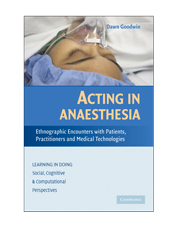Book contents
- Frontmatter
- Contents
- Series Foreword
- Acknowledgements
- Acting in Anaesthesia: Ethnographic Encounters with Patients, Practitioners and Medical Technologies
- 1 Understanding Anaesthesia: Theory and Practice
- 2 Refashioning Bodies, Reshaping Agency
- 3 Accounting for Incoherent Bodies
- 4 Teamwork, Participation and Boundaries
- 5 Embodied Knowledge: Coordinating Spaces, Bodies and Tools
- 6 Recognising Agency, Legitimating Participation and Acting Accountably in Anaesthesia
- References
- Index
- Titles in the series
3 - Accounting for Incoherent Bodies
Published online by Cambridge University Press: 20 August 2009
- Frontmatter
- Contents
- Series Foreword
- Acknowledgements
- Acting in Anaesthesia: Ethnographic Encounters with Patients, Practitioners and Medical Technologies
- 1 Understanding Anaesthesia: Theory and Practice
- 2 Refashioning Bodies, Reshaping Agency
- 3 Accounting for Incoherent Bodies
- 4 Teamwork, Participation and Boundaries
- 5 Embodied Knowledge: Coordinating Spaces, Bodies and Tools
- 6 Recognising Agency, Legitimating Participation and Acting Accountably in Anaesthesia
- References
- Index
- Titles in the series
Summary
Frequently, in medical practice, there will be multiple, incompatible explanations of a patient's condition, prompting numerous and different possible courses of action. Decision making, in these circumstances, has been analysed as a process of alignment – by bringing together various sources of knowledge, and weighing one against the other, a narrative is produced, which explains the majority of the patient's signs, symptoms, readings and measurements. More recently in STS, attention has turned from looking at methods of closure – how, of all the paths that might possibly be taken, options are reduced and a single path emerges – to exploring the multiplicities, disunities and incoherences of bodies, objects and knowledges (see, in particular, Berg and Mol, 1998, and Mol, 2002). Here, analyses have highlighted how, despite there being tensions, differences are not necessarily resolved, they endure.
In the last chapter I sought to disturb the view that anaesthetised patients are passive, stripped of agency and seemingly absent from proceedings in which they are central. In this chapter I seek to explore the anaesthetist's role in the organisation and delivery of anaesthetic care and how accountability is achieved both in circumstances where the messages conveyed by the anaesthetised patient and anaesthetic technologies – the cyborg – are relatively coherent, and circumstances where they are not. In the case of the latter, I examine the ways in which anaesthetic practice is shaped and accountability is achieved where, despite concerted efforts at alignment, the disunity of the patient's body persists.
- Type
- Chapter
- Information
- Acting in AnaesthesiaEthnographic Encounters with Patients, Practitioners and Medical Technologies, pp. 61 - 104Publisher: Cambridge University PressPrint publication year: 2009



